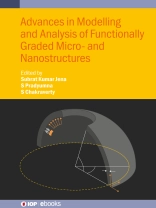The objective of this book is to bring together the latest research and developments in functionally graded nano and microstructures and their applications in advanced technologies. This book covers a range of mathematical and computational topics including different analytical, semi-analytical, and numerical procedures along with their corresponding simulation results, whilst also addressing the challenges posed by various nonlocal theories, complicating effects, in the mathematical modeling. This book is essential material for graduate students, researchers, and professionals in mechanical & civil engineering, applied mathematics, materials science and related fields.
Key Features:
- Covers the preliminary and development of FGM nano and microstructures
- The book provides an in-depth background on the mathematical methods
- Incudes computational procedures with simulation results
- Provides a variety of easy-to-understand example problems
- Uses different analytical, semi-analytical and numerical procedures for finding exact and/or approximate solutions of governing equations
Зміст
Chapter 1: Introduction to Functionally Graded Micro and Nano Structures
Chapter 2: Static Analysis of Functionally Graded Micro or Nano Beams
Chapter 3: Static Analysis of Functionally Graded Micro or Nano Beams with Complicating Effects
Chapter 4: Static Analysis of Functionally Graded Micro or Nano Plates
Chapter 5: Static Analysis of Functionally Graded Micro or Nano Plates with Complicating Effects
Chapter 6: Stability Analysis of Functionally Graded Micro or Nano Beams
Chapter 7: Stability Analysis of Functionally Graded Micro or Nano Beams with Complicating Effects
Chapter 8: Stability Analysis of Functionally Graded Micro or Nano Plates
Chapter 9: Stability Analysis of Functionally Graded Micro or Nano Plates with Complicating Effects
Chapter 10: Vibration Analysis of Functionally Graded Micro or Nano Beams
Chapter 11: Vibration Analysis of Functionally Graded Micro or Nano Beams with Complicating Effects
Chapter 12: Vibration Analysis of Functionally Graded Micro or Nano Plates
Chapter 13: Vibration Analysis of Functionally Graded Micro or Nano Plates with Complicating Effects
Про автора
Dr. Subrat Kumar Jena is a Postdoctoral Fellow at the Department of Applied Mechanics in the Indian Institute of Technology Delhi, New Delhi, India. Prior to this, he had an Honorary Post-doctoral Fellowship at the Nonlinear Multifunctional Composites – Analysis & Design (NMCAD) Laboratory, Department of Aerospace Engineering, Indian Institute of Science, Bengaluru, India. With a Ph D from the National Institute of Technology Rourkela, Dr. Jena’s research encompasses Computational Solid Mechanics, Applied Mathematics, Mathematical Modelling, and Uncertainty Modelling. He has a publication record of 35 research papers in peer-reviewed international journals and 6 books so far.
Prof. S. Pradyumna has more than 15 years of experience in academia. Presently, he is working as a Professor in the Department of Applied Mechanics at Indian Institute of Technology Delhi, India. Pradyumna teaches subjects such as Mechanics, Solid Mechanics, Finite Element Method, Dynamics to undergraduate and graduate students. His areas of research interest include composite structures, functionally graded materials, plate and shell structures, computational mechanics. He has published about 40 papers in the peer reviewed national/international journals and presented 40 papers in the national/international conferences.
Prof. S. Chakraverty has 30 years of experience as a researcher and teacher. Presently, he is working in the Department of Mathematics, National Institute of Technology, Rourkela, Odisha, as a senior professor. Prior to this, he was with CSIR-Central Building Research Institute, Roorkee, India. He has authored/co-authored/edited several books and published over 445 research papers in journals and conferences. He is in the editorial boards of various international journals, book series, and conferences. His current research areas include differential equations, numerical analysis, computational solid mechanics, fluid mechanics, soft computing, and machine intelligence.












